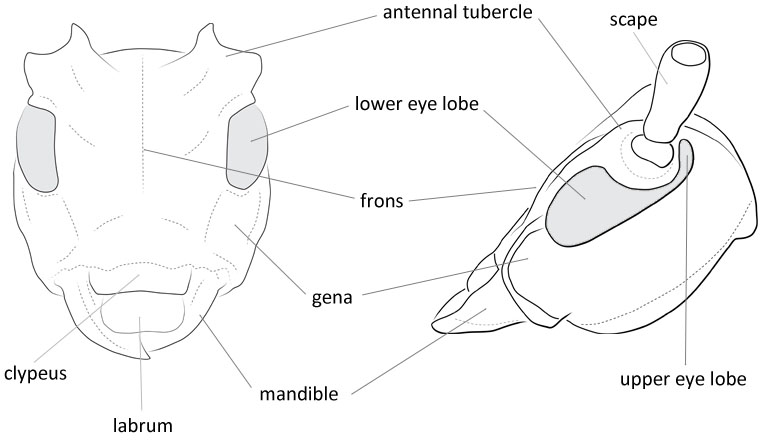Body length: 3.5–17 mm.
Eyes: eye interommatidial setaeseta:
a sclerotized hair-like projection of the cuticle
absent, eye divided—max one row of facets between, eye ommatidial density coarse.
Antennaeantenna:
in larval and adult insects, paired segmented appendages, borne one on each side of the head, functioning as sense organs and bearing a large number of sensilla
: antennal length reaches between basebase:
the part of any appendage or structure that is nearest the body
and end of elytraelytron:
the leathery forewing of beetles, serving as a covering for the hind wings, commonly meeting opposite elytron in a straight line down the middle of the dorsum in repose
or reaching/surpassing end of body, antennal flagellar segments elongateelongate:
much longer than wide
, scapescape:
the first proximal segment of the antenna smooth/punctate at apexapex:
smooth/punctate at apexapex:
end of any structure distad to the base
, antennal segment 3 > scapescape:
the first proximal segment of the antenna .
.
Pronotumpronotum:
the upper and dorsal part of the prothorax
: pronotumpronotum:
the upper and dorsal part of the prothorax
shape transversetransverse:
broader than long
, pronotumpronotum:
the upper and dorsal part of the prothorax
lateral armature absent.
Prosternum: prosternal processprosternal process:
a posterior extension of the prosternum between the coxae dilated at apexapex:
dilated at apexapex:
end of any structure distad to the base
, procoxal cavities closed posteriorly.
Elytraelytron:
the leathery forewing of beetles, serving as a covering for the hind wings, commonly meeting opposite elytron in a straight line down the middle of the dorsum in repose
: elytral length reaching or close to end of abdomen, elytral apicesapex:
end of any structure distad to the base
rounded or truncatetruncate:
cut off squarely at the tip
or with tooth or spinespine:
a protuberance with an acute (sharp) distal end
, elytral color pattern present.
Legs: visible tarsomerestarsomere:
subdivision or article of the tarsus, usually numbering from two to five : 4, femora slender or robust, protibial spursprotibial spur:
: 4, femora slender or robust, protibial spursprotibial spur:
sclerotized spine(s) located at the distal tibia; can be single, double, or absent : 2, tarsal clawstarsal claw:
: 2, tarsal clawstarsal claw:
usually paired claws of the pretarsus, at the distal end of the leg simple.
simple.
Long-oval to very elongated. Antennaeantenna:
in larval and adult insects, paired segmented appendages, borne one on each side of the head, functioning as sense organs and bearing a large number of sensilla
fine and strong, much shorter to much longer than the body, with no or short to moderately long fringed underneath; the first segment short to moderately long, sometimes with an apical spinespine:
a protuberance with an acute (sharp) distal end
or with a lateral longitudinal cristacrista:
a prominent, longitudinal carina on the upper surface of any part of the head or body
, very often triangular, the third link shorter or longer than the fourth or than the first. Antennal tubercles usually quite far apart and usually not very protruding. Eyes rather roughly faceted, subdivided. Pronotumpronotum:
the upper and dorsal part of the prothorax
mostly transversetransverse:
broader than long
, laterally more or less rounded, rarely with a lower anterior lateral hump near the anterior margin. Elytraelytron:
the leathery forewing of beetles, serving as a covering for the hind wings, commonly meeting opposite elytron in a straight line down the middle of the dorsum in repose
more or less long, arched, usually occupied with raised longitudinal lines, bumps, humps, or longitudinal ridges, usually slightly wider than the pronotumpronotum:
the upper and dorsal part of the prothorax
, head retractable or not fully retractable. Prosternal processprosternal process:
a posterior extension of the prosternum between the coxae narrow, lower than the coxae, evenly rounded. Mesosternal processmesosternal process:
narrow, lower than the coxae, evenly rounded. Mesosternal processmesosternal process:
a prolongation of the mesosternum extending between the mesocoxae
inclined anteriorly too gradually. Metasternum of normal length. Legs moderately long. The thighs culled. Sometimes at least individual parts of the body are covered with protruding hair (Breuning 1965Breuning 1965:
Breuning S. 1965. Revision der 35. Gattung der Pteropliini der asiatischen Region (Col. Cerambycidae). Entomologische Arbeiten aus dem Museum G. Frey, Tutzing bei München 16: 161–472.).
Mesosella, Ropica
The almost completely divided eyes will differentiate from Mesosella.
Palearctic, Indomalaya, Afrotropical, Australasia
broadleaf; Abies, Larix
462 spp + 14 more sspp. 29 additional subgenera not treated here. Conifers and broadleaf: P. (Pterolophia) granulata (Motschulsky). Key to many Asian species in Breuning 1965Breuning 1965:
Breuning S. 1965. Revision der 35. Gattung der Pteropliini der asiatischen Region (Col. Cerambycidae). Entomologische Arbeiten aus dem Museum G. Frey, Tutzing bei München 16: 161–472..
Praonetha Dejean, 1835
Prioneta Blanchard, 1853
Theticus Thomson, 1858
Praonetha Pascoe, 1862
Prionetopsis Thomson, 1864Thomson, 1864:
Thomson J. 1864–65. Systema cerambycidarum ou exposé de tous les genres compris dans la famille des célrambycides et familles limitrophes. H. Dessain, Liége, 578 pp. [1864: pp. 1–352; 1865: 353–578; Also published in Mémoires de la Société Royale des Sciences de Liége 19 [1866]: 1–578].
Cormia Pascoe, 1864
Alyattes Thomson, 1864Thomson, 1864:
Thomson J. 1864–65. Systema cerambycidarum ou exposé de tous les genres compris dans la famille des célrambycides et familles limitrophes. H. Dessain, Liége, 578 pp. [1864: pp. 1–352; 1865: 353–578; Also published in Mémoires de la Société Royale des Sciences de Liége 19 [1866]: 1–578].
Eurycotyle Blessig, 1873
Acroptycha Quedenfeldt, 1888
Pterolophia (Incamelomorpha) Pic, 1926
Pterolophia Newman, 1842